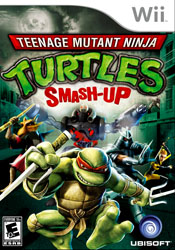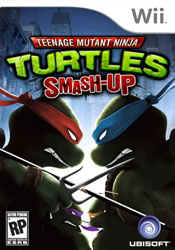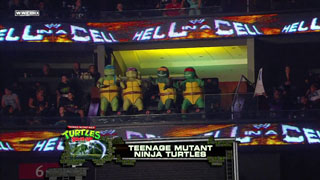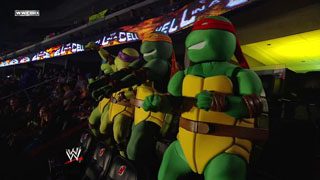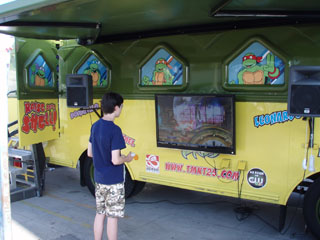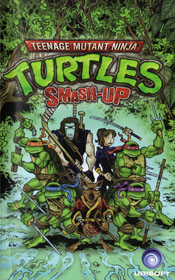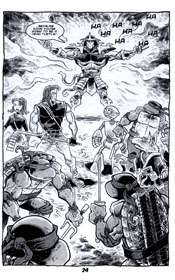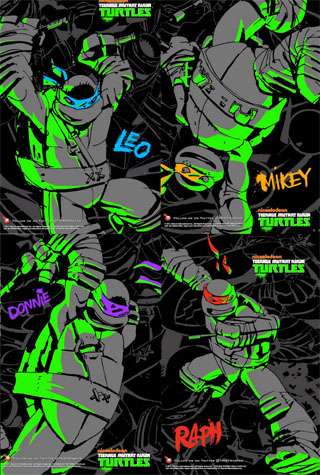
|
Next Page >>> |
|
Page 1: |
Page 2: |
Page 3: |
Page 4: |
Page 5: |
|
Page 6: |
Page 7: |
Page 8: |
Page 9: |
Page 10: |
|
Page 11: |
Page 12: |
Page 13: |
Page 14: |
|
In the last issue of Nintendo Power in 2008, the magazines teased that their next reveal would show that the Ninja Turtles were back for an exclusive Nintendo adventure, and that it would wow fans of the long running phenomenon. Speculations ran pretty rampant as to what the game would end up being, with some websites reporting that it was simply Re-Shelled repackaged into a retail product. The January 2009 edition of Nintendo Power could finally exclusively reveal an all new fighting game starring the TMNT, but not just any fighting game. For what seemed like a dream scenario, Ubisoft revealed they had teamed up with Game Arts who was responsible for co-developing Smash Bros Brawl, and as such the new game would be based on a modified engine of that found in the Nintendo based all-star fighter. In addition, to flesh out the game design to make use of more traditional fighter elements, former members of Team Ninja of Dead or Alive and Ninja Gaiden fame were added to the team in what seemed like an announcement too good to be true for longtime fans.
The early details continued to create unprecedented hype. The graphics were to be based closer on the 2007 movie, but Ubisoft made it strictly clear that this game was to celebrate the 25th anniversary of the shell carrying ninjas, and therefore the entire TMNT library, past and present, were being taken into consideration for roster, locations and design. A production blog was even set up with cooperation of IGN, where the developers would show off new designs for stages and talk about their partnership with Peter Laird and Mirage, touting the access they had gotten into the vast universe of TMNT and how the excitement internally in the team was unspeakable due to the plans they had for the game. Eventually the title was revealed to be Teenage Mutant Ninja Turtles: Smash-Up, and the game enjoyed a marketing campaign the likes of major blockbusters and was by far the biggest ad campaign ever employed to a TMNT product with the quartet of radicals even appearing live on WWE wrestling television to promote their product. A traveling party wagon was also built with demo stations on the side of the van for eager players to try out the game.
Smash-Up is not only similar to Smash Bros in name; it is near identical overall. So much so that even some animations from Smash Bros has actually been brought over, though most of the animations were made for Smash-Up specifically. The differences are mostly found in the general interface which has a darker industrial kind of layout, and the fact that matches now feature a health bar rather than the increasing percentage counter which leads to greater speeds and distances which the characters are thrown at in Smash Bros, though it is still possible to win by throwing the opponents beyond the stage borders. Most of the modes from Smash Bros are here under a renamed banner, like battle royals and target modes. Smash-Up offers the chance to team up characters an swap between them mid battle and combine their strikes together for some effective combos. It also includes an adventure mode which appears as Arcade Mode in this game. Apart from the Arcade Mode, nearly all types of modes are available for online play.
Splinter has decided to test his sons in combat by setting up a tournament in which he himself will participate, along with Casey Jones and April. The winner is promised a trophy to mark their victory and also a prized possession in Splinter's own cabinet filled with treasures from around the world. In the midst of this tournament, things go awry when a distress call is received from Fugitoid, alerting the Ninja Turtles that he has been kidnapped by The Shredder and needs to be saved. Shredder himself takes his rightful place on daytime television in a broadcast where he dares the turtles to come save their friend in need. Unsure of where to start, they suddenly get help from an unexpected ally, Karai. The story plays out in cutscenes between each stage in the form of motion comic books, all illustrated by longtime TMNT penciller Jim Lawson with a script overseen by Peter Laird and written by Ubisoft's Matt Luenig. The voice cast from the 2k3 series reprises their respective roles for this game.
In battle, the game will be instantly familiar to those who have played Smash Bros before. There are two attack buttons, a standard attack and a special attack which changes with the combination of a direction. If the standard attack button is held down along with a direction, the strike will be charged with extra power. Characters can block for a limited amount of time, and pick up items which are scattered across the stages as well as pick up their opponents and throw them down and sunder. The game supports all types of available controllers for Wii, being the nunchuk/remote combo, single Wii remote, classic controller and GameCube pad.
The main (and only) addition to the battle engine is the new ability to use walls and ledges to actually launch attacks from, being able to hang onto walls and perform devastating diving strikes or gain some high ground in case a bearded man has the advantage. Beyond the ability to use the walls to perform new moves, there are actually no changes made to the engine and remains identical to Smash Bros, even down to the announcer.
Smash-Up differentiates itself the most from its obvious inspiration in the way stages are handled. In Smash-Up, most of the stages are highly interactive and dynamic, changing constantly due to demolition or lurking hazards which impacts the outcome of each match drastically. Apart from two static stages, the locations will make use of its environments to really spice up the feel for each individual stage, by for example bringing a temple fully on fire and deteriorating, or even more dramatically drive a cruise ship into an iceberg and sink into the ocean only for the battle to continue on the back of a blue whale surrounded by white sharks. Yep, you read that right. Four mutated ninja turtles, fighting on a sinking boat until the very last second before jumping onto the back of the world's largest mammal, circled by sharks and continuing their fight.
Like any TMNT game since 2003, Smash-Up features a large number of unlockable items, both in line with the artwork based secrets familiar to the franchise and also the Smash Bros style emblems and figurines. These are unlocked mostly in the Arcade Mode, which features a shooting range where prizes show up and can be shot with shells that are earned in the various bonus stages in the game, like Pizza Party , basically Targets from Smash Bros), Climb which is a race to reach the top of the stage, Block The Kunai which requires the player to dodge kunai, Bustin Blocks which is essentially another variation of Targets and Stay Alive, a desperate survival by staying out of the waters. Shells can also be used to create your very own trophies which can be offered in local tournaments or put up for grabs on the online mode. Most characters also have an alternate costume that can be unlocked.
Finally it's time to look at the roster of characters for this 25th anniversary celebration, one that promised to deliver surprises one would not expect to see. Well, hopefully you didn't expect to see anyone at all because the roster is quite sparse. Apart from the Ninja Turtles, Splinter, April and Casey, the game serves up Karai, Shredder, a Foot Ninja, Fugitoid and Ultrominator. There are some very special surprise unlockable characters to be found however, namely...the Raving Rabbids.
Teenage Mutant Ninja Turtles: Smash-Up (Wii)
Really, Raving Rabbids. How can this even be real? Even Trevor McFur would be a better choice. It's one of the biggest flaws with this game, and quite a critical one at that when the game's roster is so weak and uninteresting considering the amount of hype was put into the potential of included characters, and we end up with not one but three characters which aren't even from the actual TMNT universe. There is actually a lot that points towards the fact that Smash-Up seems to have hit a wall, whether or not this was because of budget concerns or outside pressure is not clear however. In several interviews done with 1up and other large publications before the release of the game, the developers early on stated that Rocksteady and Bebop would be part of the cast, two of the most popular characters throughout all of TMNT but nowhere to be found. The development blog alludes to their inclusion numerous times as well, and also goes into detail on how Mirage were heavily involved in the process of choosing the many characters that would be included, but the blog abruptly halted midway through development.
There might be several reasons why the roster is gimped to such an extent. For one, producers might have been concerned that relying heavily on past character designs and personalities from the classic cartoon or other sources might confuse younger audiences which were still seeing TMNT on TV in its current outfit. Another reason might also have been that production ran out of time and had to rush out the final polish to hit the designated release date, and there are a number of factors to back this theory up, mostly the numerous bugs found within the game.
During the multiplayer sessions, things will sometimes get very odd with the way the game tallies up the points for each round to declare a winner. And by odd, it really means that Smash-Up won't take any wins or losses into consideration and just pick a winner at random, despite displaying on screen the results of each round and clearly showing that the player who won actually did not have the most points or was the last man standing in a match. It's not an everyday occurrence but it certainly shows up enough that it becomes fairly frustrating when playing the game competitively with friends. There are also rare times where the music tracks will not play at the start of the rounds and remain silent throughout the fight, though this bug is much more rarely stumbled upon.
Another hint towards the rushed development time is the very sloppily made cutscenes in the Arcade Mode, which are quite crudely done. The art itself is good, but the way it is presented and effects are employed is extremely cheap, with flash based animation joints simply moving an arm up or down or floating a cut out of the frame across the screen. Some of the trailers made for the game makes use of rather good looking CGI and seems to have some short sequences which were to be seen in the Arcade Mode, but this might not have been finished in time.
So is Smash-Up a bad game? Well actually no, it's quite good honestly, even great at times. There are things to recommend it which travels well for gamers, even those who are overly familiar with Smash Bros. The graphics are great even though the art design is a bit bland, the stages are a true blast to play with and the diversity between them is great and the core game has been smoothened and improved with more balanced characters, no tripping feature and better online interface. Being so similar to Smash Bros, the multiplayer aspects of the game remain equally as strong in terms of sheer gameplay.
But it's the teasing of a greater product than what we actually got that makes it so hard to fully accept. For a game that relies so heavily on another series which celebrates itself by including characters from all generations and places, the bare bones cast of essentials really doesn't do the job of celebrating the rich franchise which it could take advantage of, and it isn't helped any further that it was stated so many times to not be tied down to any particular version of the TMNT but still be so underwhelming to only make use of the 2003 and 2007 designs with not so much of a hint of any other iteration besides the cutscenes. There isn't much in the way of cameos either, quite the contrast from Tournament Fighters 15 years earlier and its long list of cameo appearances.
Ultimately, the game suffers from the Ubisoft pattern of restricting its games within the norms of the genre rather than embracing the potential of the license. Even with all the hype and excitement they were able to generate, they still are only able to offer what is a game that is only good due to prior games it is based on, not what they are able to bring to the game to move it forward. The overall audio design apart from the voice acting is also weak, with sound effects and music being almost ghostly and unattendant.
Even though the game was announced as a Wii exclusive, a very hastily done port was made for the PlayStation 2. The PS2 version features worse graphics, no online play and lacks the special pack in comic book from Mirage which came with the Wii game. It is also missing Fugitoid and the Rabbids as playable characters.
Quick Info:
|
Developer: |
|
|
Publisher: |
|
|
Genre: |
|
|
Themes: |
Teenage Mutant Ninja Turtles: Smash-Up (Wii)
Teenage Mutant Ninja Turtles: Smash-Up (Wii)
Teenage Mutant Ninja Turtles: Smash-Up (Wii)
Teenage Mutant Ninja Turtles: Smash-Up (Wii)
Teenage Mutant Ninja Turtles: Smash-Up (Wii)
Teenage Mutant Ninja Turtles: Smash-Up (Wii)
Teenage Mutant Ninja Turtles: Smash-Up (Wii)
Teenage Mutant Ninja Turtles: Smash-Up (Wii)
Teenage Mutant Ninja Turtles: Smash-Up (Wii)
Teenage Mutant Ninja Turtles: Smash-Up (Wii)
Teenage Mutant Ninja Turtles: Smash-Up (Wii)
TMNT at WWE Hell in a Cell 2009 & Turtle Van
Smash-Up Comic Book
Shortly after the announcement of Smash-Up, Ubisoft teased yet another TMNT product that would also make use of the entire franchise and not tie itself down to any specific timeline or universe within. The announcement was largely overshadowed by the massive hype that surrounded Smash-Up and all of its promise, but the little information that did come out sounded impressive enough at the time as well. Revealing its name to be Teenage Mutant Ninja Turtles: Arcade Attack, the title promised to be a throwback into the past, celebrating the genre which had put the turtles solidly in the history books of video games and bring in characters from all corners. Arcade Attack would see release in November, two months after Smash-Up and just in time for the holidays.
As touted the game harkens back to the simple arcade bashers with the Ninja Turtles running through eight stages of mayhem to investigate a cybernetic disturbance. Arcade Attack doesn't try to clutter up the concept or introduce tough controls or touch screen gimmicks, only making use of two buttons as in The Arcade Game and Turtles in Time. The biggest difference between the classic games and this title in design is the fact that it makes use of 3D graphics and allows for attacks in all directions, much like Re-Shelled had introduced. The camera is dynamic and will zoom in and out on the action as it happens.
The combat in Arcade Attack lends a little bit from 1-on-1 fighters to try to spruce a little bit into the gameplay, and the dynamic camera angles serves to help that purpose out by zooming in on the action in close quarters. Strikes are strung together in combos which are tallied up on screen and can be brought into triple digits by juggling and balancing out the attacks properly. Throws can also be performed in Street Fighter style by pressing both buttons together at the very same time. In addition to the standard strikes there are also a few strikes that can be performed from a set flips and evasions, and there are weapons scattered around in barrels and crates, along with pizza naturally. In close quarters, the camera can zoom in on a weapon lock, similar to what is found in Soul Calibur where two characters are grinding their weapons together trying to overpower the other, and in these situations the on-screen displayed button must be pressed rapidly in order to win the grind.
The game is also entirely co-op, and even in single player, the second character will be played by the CPU. Through the use of DS's wireless multiplayer feature, two players can play together and work together by stringing combos together and reach high numbers, and also perform multiple team moves such as swinging eachother around and kicking furiously in a circle to take out a multitude of enemies.
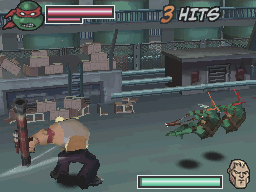
Getting those details out of the way, it's a good time to look at the actual license and how it is used. Being that Ubisoft promised a large and varied cast of familiar TMNT characters, it is only natural that the game mostly makes use of nameless thugs in track suits, and uses designs and characters exlusively from the 2003 series and not from any other previous TMNT license. But the representation is the least of Arcade Attack's problems. The entire game is quite the mess and is horribly underwhelming. The combat engine is so floaty and soft with absolutely no intensity to it, and the animations look akin to something on the early cell phone 3D titles rather than a late DS title. The graphics in general are incredibly hard to make any sense of with flat pixelated textures and blocky models which look nothing like what it is based on, especially in close up where there will essentially be a large square green block and a large black block with no detail on it.
The stages are probably the worst set of stages ever assembled in a TMNT game, basically consisting of a completely flat terrain with a few bars or alleyways in the background with no interactivety or activety for that matter. It's in all a budget line game with little to no real effort on making it feel anything like the classic arcade games, and little effort to make a good game on its own for that matter. The dual screen is used to no effect whatsoever either, which is alright considering it would mostly just be gimmicks for pulling off a move or something, but they could at least try when they were already underperforming to such a degree already. There's also little replay value to the game compared to how content heavy the titles have been since the 2003 title, but Arcade Attack only offers a ranking mode and harder difficulty once the game is completed, and why anyone would play the game over again, on a harder setting mind you, is anyone's guess.
There is a small highlight to the game, the cutscenes. Featuring artwork by Eastman and Laird, the cutscenes are the only actually authentic TMNT content you'll find in the game, and they are really well done, especially in comparison to the Smash-Up videos in similar style.
It's clear that the name is all but a tease, a scam effort to lure in old fans of the genre and the franchise to think this is in any way similar or an ode to the old, but reality soon sets in that Arcade Attack is a quick cash-in and exploit of the name it holds with absolutely no real consideration given to the overall quality of the game.
Quick Info:
|
Developer: |
|
|
Publisher: |
|
|
Genre: |
|
|
Themes: |
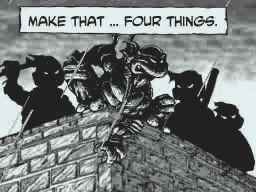
TMNT: Arcade Attack
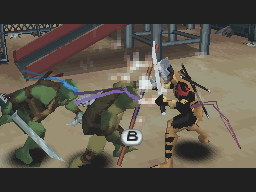
TMNT: Arcade Attack
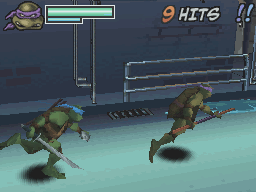
TMNT: Arcade Attack
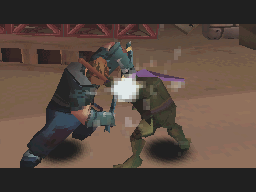
TMNT: Arcade Attack
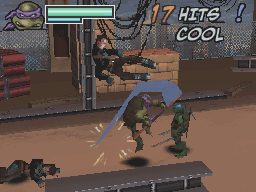
TMNT: Arcade Attack
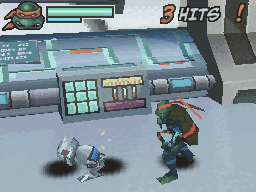
TMNT: Arcade Attack
Sadly, Arcade Attack would be the last game the TMNT franchise would see since the shocking events of October of 2009. With the television show having been sent to an end with the last season dubbed Back To The Sewers and the comic book from Mirage facing critisism over contriversial storyline decisions and lackluster writing, Peter Laird quietly announced on October 21st of 2009 that he had sold the entire stake property of TMNT to Viacom and Nickelodeon, washing his hands clean, feeling he had managed to creatively do all he could with it. Nickelodeon on their parts quickly announced a new series set for 2012, which will again reboot the series.
Since the announcement, TMNT recieved a well recieved swan song in the form of Turtles Forever, a DTV movie combining the Mirage, Toon and 2k3 cast together to take out Krang, Shredder and the Utrom across the many parallel universes of TMNT. A new live action movie, produced by none other than Michael Bay, is in the works as well. Now all that remains is to wait for the new era of TMNT to bring the heroes back to shell form and hopefully again capture the imaginations and empty the valets of young and old, and bring back the fun of fast paced, lighthearted action with friends as it once delivered better than any other.
Thanks to:
Pearl Lu (Konami of America)
Mutsuhiko Izumi (Konami of Japan)
Dan Berger (Mirage)
Michael Dooney (Mirage)
Bey Logan (TMNT Golden Harvest Information)
Additional images from tOkKa
Related Articles
|
Next Page >>> |
|
Page 1: |
Page 2: |
Page 3: |
Page 4: |
Page 5: |
|
Page 6: |
Page 7: |
Page 8: |
Page 9: |
Page 10: |
|
Page 11: |
Page 12: |
Page 13: |
Page 14: |
|
